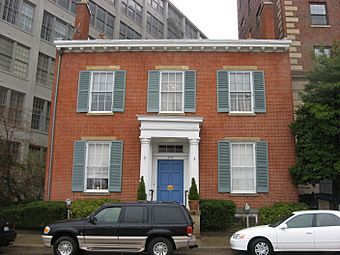Lytle Park Historic District facts for kids
Quick facts for kids |
|
|
Lytle Park Historic District
|
|

Literary Club building
|
|
| Location | Roughly bounded by 3rd, 5th, Sycamore, Commercial Sq., and Butler Sts., Cincinnati, Ohio |
|---|---|
| Area | 50 acres (20 ha) |
| Architectural style | Greek Revival, Italianate, Georgian |
| NRHP reference No. | 76001435 |
| Added to NRHP | March 26, 1976 |
The Lytle Park Historic District is a special area in Cincinnati, Ohio, United States. It's called a historic district because it has many old buildings and places that are important to history. This district is mainly around Lytle Park, in the heart of downtown Cincinnati. It's like a time capsule showing what the city was like long ago.
In 2014, a company that owns many buildings in the district wanted to build new offices. They asked the city to remove the historic protection from some buildings. But many people and groups worked hard to protect these important historical sites. This shows how much people care about keeping history alive!
Contents
Discover Lytle Park
Lytle Park has a very long and interesting history. It's one of the oldest parts of Cincinnati. Long ago, this area was a thick forest. It was also the site of Fort Washington, which was built in 1789. This fort helped protect the first settlers in Cincinnati from attacks.
The Lytle Family's Home
After the fort, the land became the home of the important Lytle family. Surveyor General of the Northwest Territory William Lytle II built his house here in 1809. This was about ten years before the famous Martin Baum mansion was finished nearby. Today, that mansion is the Taft Museum of Art.
The City of Cincinnati bought the land, then known as Lytle Square, in 1905. Lytle Park was officially opened to the public on July 6, 1907.
Lincoln's Statue and Other Memorials
At the park's entrance, you'll see a tall, 11-foot (3.4 m) bronze statue of Abraham Lincoln. The Charles P. Taft family paid for this statue. It's special because it shows Lincoln without his beard, which is unusual for statues of him. It's the only public statue of a person made by the sculptor George Grey Barnard. Former president William Howard Taft helped dedicate the statue on March 31, 1917, with a big celebration.
Near the Lincoln statue, there's also a U.S. Marine Corps Memorial. It's a large granite rock with a bronze plaque and the Marine emblem on top of a globe. This memorial was dedicated in 1921.
A Park Above a Highway
At one point, Lytle Park was almost destroyed when a new highway was planned for downtown. Former Mayor Charles P. Taft worked hard in Washington D.C. to save the park. For six years, groups of citizens from all over the city fought to protect this area.
Eventually, a plan was made to build a tunnel for the highway. Lytle Park was then rebuilt on top of this tunnel. When the Lytle Tunnel was finished in 1970, Lytle Park became the first park in the world to be located above an interstate road.
Today, Lytle Park is known as a beautiful "urban oasis." It's famous for its large flower beds, which are full of colorful tulips and chrysanthemums. It's a peaceful green space right in the middle of the busy city.
Historic Buildings in the District
In 1976, the buildings around Lytle Park were officially recognized as a historic district. This meant they were added to the National Register of Historic Places. The district shows off different styles of old buildings, like Georgian, Greek Revival, and Italianate designs. This area was once a fancy neighborhood where important families lived, and it was kept separate from the city's factories and businesses.
Some of the important buildings in the Lytle Park Historic District include:
- The Baum-Taft House, which is now the Taft Museum of Art.
- The Literary Club of Cincinnati.
- The former Anna Louise Inn building, built in 1909.
- Christ Church Cathedral.
- The Guilford School building, built in 1914.
- The Phelps building, built in 1926, which is now a hotel.
- Police Station No. 2.
- The University Club of Cincinnati.
- The Western & Southern Financial Group building.
These buildings, along with Lytle Park itself, help tell the story of Cincinnati's past and are important parts of its history.




